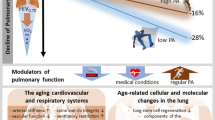Abstract
The measurement of functional residual capacity (FRC) has assumed new importance in the diagnosis of acute respiratory failure. However few reference values exist for FRC in supine positions for both sexes. We measured the FRC in 100 healthy subjects with the helium dilution closed circuit method in the sitting and supine positions. There were 50 women aged 20 to 63 years and 50 men aged 22 to 65 years. Fifty five subjects were smokers (25 women and 30 men) but no significant differences were found between FRC of smokers and nonsmokers. The FRC always decreased when the subject changed from the sitting to supine position. In this study, the correlation coefficients between FRC and height were statistically significant for both sexes, the influence of age and weight on FRC being negligible. Our results provide useful reference values for FRC in the supine position.
Similar content being viewed by others
References
Falke KJ, Pontoppidan H, Kumar A, Leith DE, Geffin B, Laver MB (1972) Ventilation with end-expiratory pressure in acute lung disease. J Clin Invest 51:2315–2323
Whitfield AGW, Waterhouse JA, Arnott WM (1950) The total lung volume ans its subdivisions. A study in phsysiological norms. I. Basic data. Br J Soc Med 4:1–25
Medical Research Council (1965) Definition and classification of chronic bronchitis for clinical an epidemiological purposes. Lancet 1:775–779
Cotes JE (1975) Lung function. Backwell, London p. 113
Ibáñez J, Moris SG, Marsé P, Abizanda R, Fiol M., Abadal JM (1979) Diferencias en la función pulmonar de sujetos sanos secundarias al cambio postural. Med Clin 73:149–152
Needham CD, Rogan MC, McDonald I (1954) Normal standards for lung volumes, intrapulmonary gas mixing and maximum breathing capacity. Thorax 9:313–325
Goldman HI, Beclake MR (1959) Respiratory function tests. Normal values at median altitudes and the prediction of normal results. Am Rev Tuberc 79:457–467
Grimby G, Söderholm B (1963) Spirometric studies in normal subjects. III. Static lung volumes and maximum voluntary ventilation in adults with a note on physical fitness. Acta Med Scand 173:199–206
Pasquis P (1975) Normal values of functional residual capacity. Bull Physiopathol Respir 11:823–826
Hall AM, Heywood C, Cotes JE (1979) Lung function in healthy British women. Thorax 34:359–365
Whitfield AGW, Waterhouse JAH, Arnott WM (1950) The total lung volume and its subdivisions. A study in physiological norms. III. Correlations with other anthropometric data. Br J Soc Med 4:113–116
Hurtado A, Fray WW, Kaltreider NL, Brooks WDW (1934) Studies of total pulmonary capacity and its subdivisions. V. Normal values in female subjects. J Clin Invest 13:169–191
Hurtado A, Boller C (1933) Studies of total pulmonary capacity and its subdivisions. I. Normal absolute and relative values. J Clin Invest 12:793–806
Kaltreider NL, Fray WW, Hyde HV (1938) The effect of age on the total pulmonary capacity and its subdivisions. Am Rev Tuberc 37:662–689
Moreno F, Lyons HA (1961) Effect of body posture on lung volumes. J Appl Physiol 16:26–29
Craig DB, Wahba WM, Don HF, Couturet JG, Becklake MR (1971) “Closing volume” and its relationship to gas exchange in seated and supine positions. J Appl Physiol 31:717–721
Boren HL, Kory RC, Syner JC (1966) The Veterans Administration Army cooperative study of pulmonary function. II. The lung volume and its subdivisions. Am J Med 41:96–114
Nunn JJ (1977) Applied respiratory physiology. Butterworths, London, pp 67–68
Pontoppidan H, Geffin B, Lowenstein E (1972) Acute respiratory failure in the adult. N Engl J Med 287:690–698
Ramachandran PR, Fairely HB (1970) Changes in functional residual capacity during respiratory failure. Can Anaesth Soc J 17:359–369
Powers SR, Burdje R, Leather R (1972) Studies of pulmonary insufficiency in non-thoracic trauma. J Trauma 12:1–14
Suter PM, Fairley HB, Isenberg MD (1975) Optimum endexpiratory airway pressure in patients with acute respiratory failure. N Engl J Med 292:284–289
Laws HK (1968) Effect of induction of anaesthesia and muscle paralysis on functional residual capacity. Can Anaesth Soc J 15:325–331
Rehder K, Hatch DJ, Sessler AD, Marsh HM, Fowler WS (1971) Effects of general anesthesia, muscle paralysis and mechanical ventilation on pulmonary nitrogen clearance. Anesthesiology 35:591–601
Ibáñez, Raurich JM, Moris SG (1981) Measurement of functional residual capacity during mechanical ventilation. Comparison of a computerized multiple nitrogen washout method with the closed helium dilution method. Crit Care Med 9:177
Author information
Authors and Affiliations
Rights and permissions
About this article
Cite this article
Ibañez, J., Raurich, J.M. Normal values of functional residual capacity in the sitting and supine positions. Intensive Care Med 8, 173–177 (1982). https://doi.org/10.1007/BF01725734
Received:
Issue Date:
DOI: https://doi.org/10.1007/BF01725734




